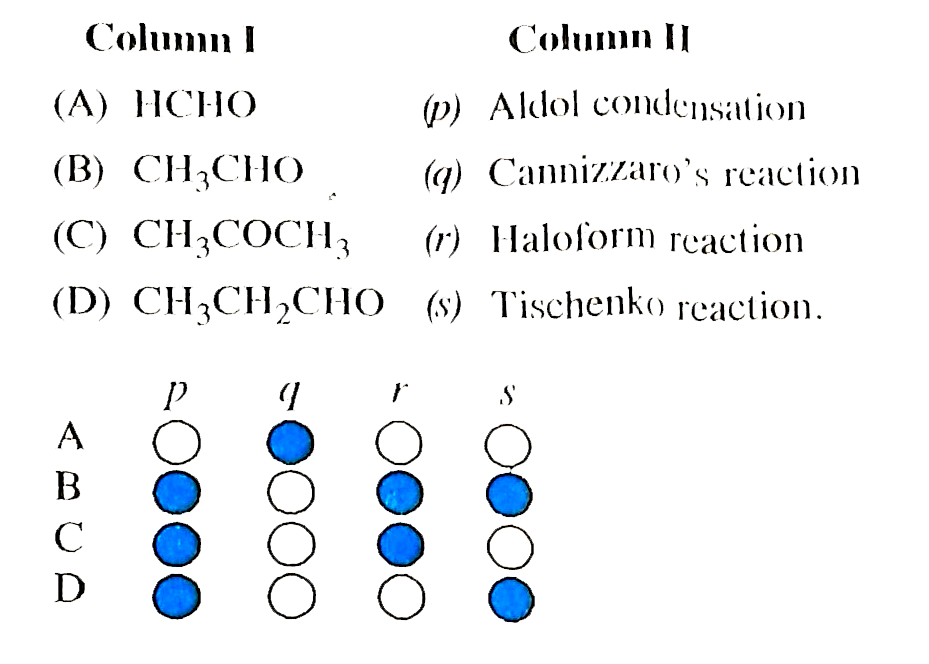Complete Solutions to Asseration-Reason Type Question of chapter ALDEHYDES AND KETONES of Class 12 book with complete answers and questions
| Class 12 | CHEMISTRY |
| Chapter | ALDEHYDES AND KETONES |
| DINESH COMPANION CHEMISTRY | Asseration-Reason Type Question |
| Number Of Questions | 28 |
| Academic Year | 2023-24 |
Assertion : Carbonyl compounds take part in nucleophilic addition reactions.
Reason : These reactions are initiated by nucleophilic attack at the electron deficient carbon atom.
View SolutionAssertion : Lower members of carbonyl compounds are water soluble.
Reason : These compounds are of polar nature.
View SolutionAssertion : All aldehydes donot take part in aldol condensation.
Reason : In th aldol condensation, carbanion is generated by the abstraction of` alpha`-H atopm by the base.
View SolutionAssertion : Fehling reagent is a test for all aliphatic aldehydes.
Reason : Aliphatic aldehydes can be easily oxidised even with mild oxidising agents.
View SolutionAssertion : Acetone is less reactive towards nucleophilic addition than acetaldehyde.
Reason : The alkyl groups hinder the nucleophilic attack on carbonyl carbon atom.
View SolutionAssertion : Pentan-2-one and pentan-3-one can be distinguished by iodoform test.
Reason : Only methylketines take part in iodoform reaction.
View SolutionAssertion : The addition of ammonia derivatives to carbonyl compounds is carried in weakly acidic medium.
Reason : In weakly acidic medium attacking nucleophile is also protonated.
View SolutionAssertion : `LiAlH_(4)` is more reactive and less selctive than `NaBH_(4)` as a reducing agent.
Reason : `LiAlH_(4)` reduces both aldehydic group and double bond in conjugate position while `NaBH_(4)` does not.
View SolutionAssertion : It is not so easy to oxidise primary alcohols to aldehydic stage.
Reason : Aldehydes are prone to furthr oxidation to carbonxylic acids.
View SolutionAssertion : Alcohols are more boinling than aldehyes of comparable molecular masses.
Reason : Stric hindrance is more than in acetaldehyde.
View SolutionAssertion : Benzaldehyde is less reactive towards nucleophilic addition than acetaldehyde.
Reason : In benzaldehydes, steric hindrance is more than in acetaldehyde.
View SolutionAssertion : Acid chlorides can not be converted to ketones by reacting with Grignard reagents.
Reason : Ketones further react with Grignard reagents to give tertiary alcohols.
View SolutionAssertion: Hydroxyketones are not directly used in Grignard reaction.
Reason : Griganard reagnts react with hydroxyl group.
View SolutionAssertion: Isobutanal does not give iodoform test.
Reason : It does not have `alpha`-hydrogen.
View SolutionAssertion : Chloral hydrate is a stable compound.
Reason : It is stable due to high molecualr mass.
View SolutionAssertion : Aldehydes or ketones on heating with hydrazine and KOH or pot, tert butoxide in high boiling solvent such as ethylene glycol give the reduced product.
Reason : The reaction is known as Clemmensen's readuction.
View SolutionAssertion : `alpha`-hydrogen atoms in aldehydes or ketones are acidic.
Reason : Anions formed aftrt the loss of `alpha`-hydrogen atoms are stablished due to inductive effect.
View SolutionAssertion : Pentan-2-one and pentan-3-one can be distinguished with the help of iodoform test.
Reason : Pentan-2-one is a methyl ketones but pentan-3-one is not.
View SolutionAssertion : `RCOCl` is reduced to `RCHO` with `H_(2)` using `Pd//BaSO_(4)` catalyst contaning a small amount of sulphur.
Reason : RCHO is further reduced to `RCH_(2)OH`.
View SolutionAssertion : Grignard's synthesis is always carried in ethereal solution.
Reason : Water is polar solvent.
View SolutionAssertion : Cannizzaro's reaction is a disproportionation reaction.
Reason : It is a hydric ion transfer reaction.
View SolutionAssertion: `(CH_(3))_(3)C COC(CH_(3))_(3)` and acetone can be distanguished by the reaction with `NaHSO_(3)`.
Reason : `HSO_(3)` is the nucleophile in bisulphite addition.
View SolutionAssertion : Aldol condensation can be catalysed both by acids and bases.
Reason : `beta`- hydroxy aldehydes or ketones readily undergo acid catalysed dehydration.
View SolutionAssertion : Mixture of benzaldehyde and acetaldehyde in hot alkaline medium gives cinnamaldehyde.
Reason : Benzaldehyde is strong electrophile than acetaldehyde.
View SolutionAssertion : Aromatic aldehydes and formaldehyde undergo Cannizzaro reaction
Reason : Aromatic aldehydes are almost as reactive as formaldehyde.
View SolutionMatch the following columns

View SolutionMatch the following columns

View SolutionMatch the following columns

View Solution
Asseration-Reason Type Question questions and complete solutions for chapter ALDEHYDES AND KETONES of S DINESH & CO CHEMISTRY (HINGLISH) of Class 12
All Exercises from DINESH COMPANION CHEMISTRY Class 12 CHEMISTRY ALDEHYDES AND KETONES
- Additional Important Question
- Asseration-Reason Type Question
- Completion Of The Missing Links
- Completion Reactions
- Comprehension 2
- Comprehension 3
- Comprehension 4
- Comprehension 5
- Comprehension 6
- Comprehension 7
- Comprehension I
- Example
- Higher Order Thinking Skills
- Interger
- Match the coloumn
- Multiple Choice
- Nomenclature and Isoerism
- Practice Test
- Preparation of Carbonyl
- Problem
- Properties of Carbon
- Question From Board
- Select the correct answer
- Some Typical Conversions